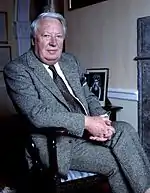Second Shadow Cabinet of Edward Heath
The Second Shadow Cabinet of Edward Heath was created after the Conservative Party lost the February 1974 general election. It was led by the Leader of the Conservative Party Edward Heath and featured prominent Conservative politicians both past and future. Included was Heath's successor Margaret Thatcher, the future Home Secretary William Whitelaw, and two future Foreign Secretaries, Lord Carrington and Francis Pym. For the first time in history, a leadership election was held in 1975 for the Conservative Party whilst the position was not vacant. Margaret Thatcher challenged Heath, with whom the majority of the party was dissatisfied because of repeated losses at elections. She won, becoming the first female leader of a major political party in Britain.

Shadow cabinet list
| Portfolio | Shadow Minister | Term |
|---|---|---|
| Leader of Her Majesty's Most Loyal Opposition Leader of the Conservative Party |
The Rt Hon. Edward Heath | 1974–75 |
| Shadow Chancellor of the Exchequer | The Rt Hon. Robert Carr | 1974–75 |
| Shadow Foreign Secretary | The Rt Hon. Geoffrey Rippon | 1974–75 |
| Shadow Home Secretary | The Rt Hon. Jim Prior | 1974 |
| The Rt Hon. Keith Joseph | 1974–75 | |
| Shadow Secretary of State for Defence | The Rt Hon. Ian Gilmour | 1974 |
| Shadow Secretary of State for Education and Science | The Rt Hon. Norman St John-Stevas | 1974–75 |
| Shadow Leader of the House of Commons | The Rt Hon. Jim Prior | 1974 |
| The Rt Hon. John Peyton | 1974–75 | |
| Shadow Secretary of State for the Environment | The Rt Hon. Margaret Thatcher[1] | 1974–75 |
| Shadow Secretary of State for Northern Ireland | The Rt Hon. Francis Pym | 1974 |
| The Rt Hon. Ian Gilmour | 1974–75 | |
| Opposition Chief Whip | The Rt Hon. Humphrey Atkins | 1974–75 |
| Leader of the Opposition in the House of Lords | The Rt Hon. The Lord Carrington PC | 1974–75 |
References
Further reading
- Margaret Thatcher: The Authorized Biography Volume 1: Not For Turning by Charles Moore